Due to popular demand, we hired pipe enthusiast and maker Steve Morrisette to write a guide about pipes, Enjoy!
I am a pipe maker. This piece is about tobacco smoking pipes.
“When loves grows cool, thy fire still warms me; When friends are fled, thy presence charms me. If thou art full, though purse be bare, I smoke and cast away all care!”
German Smoking Song

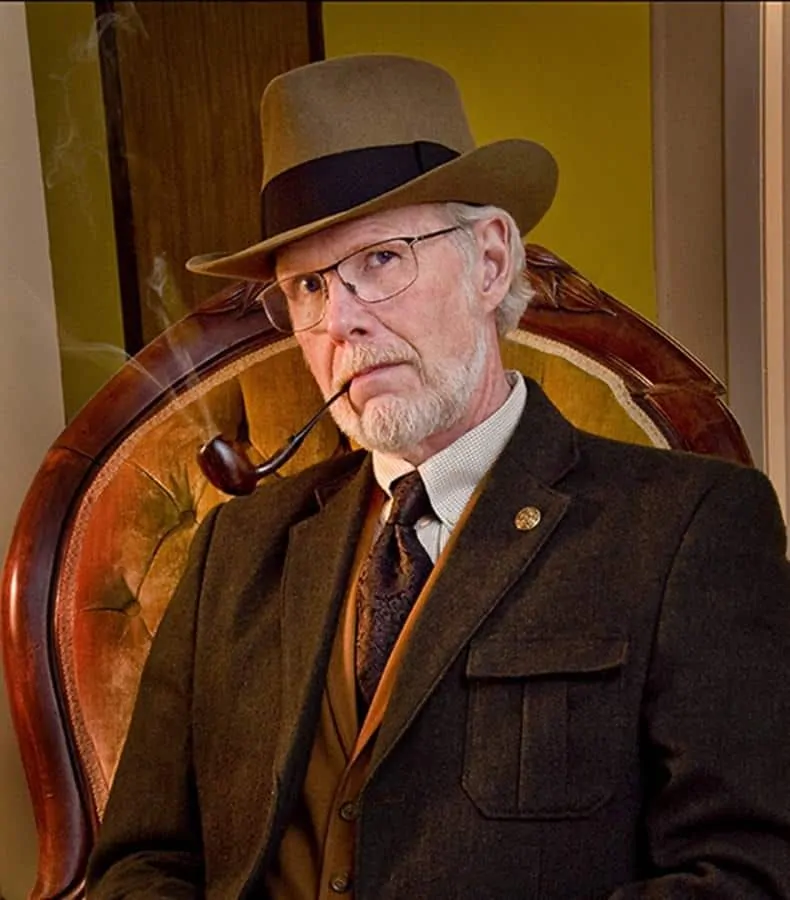

Pipes and thoughtful contemplation have been good companions to each other, and Man, for many centuries. I love pipes and pipe smoking and find little to rival the sublime experience of sitting, smoking and thinking. Indeed, some of my fondest memories are of sitting at a sidewalk cafe, smoking a good blend and being “present” to experience life unfolding all around me. I have done this on four continents and never tire of it, nor will I ever lose my enthusiasm for time spent with a clan of pipe smokers, invariably engaged in a fine conversation. These small, ancient, and revered objects, thus employed, have fostered great friendships, delighted the senses and soothed souls for millennia. Currently, and much to my delight, pipe smoking is enjoying a resurgence of popularity.
Over the past twenty years I progressed from an avid pipe smoker, to collector of high grade hand made artisan pipes and on to creating pipes for others to enjoy. I have formed, revised, and re-formed many opinions and conclusions about the smoking, collecting and the making of pipes over the years. I am still enthusiastically learning today and it is my great privilege to share with you a bit of what I have learned and absorbed. I am happy to see that pipe smoking seems to become more popular again. Tn the following I will briefly discuss the history of pipes, explain the mechanics, buying options, how to clean it, and of course how to smoke a pipe.

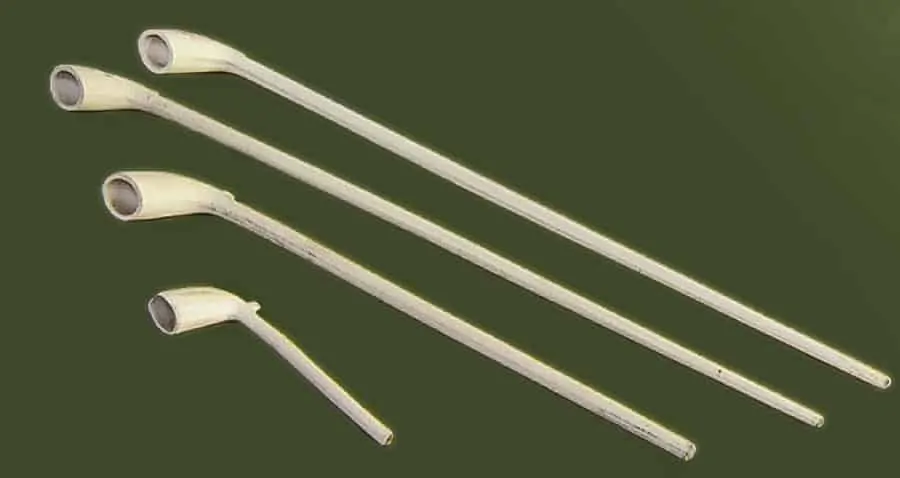
The History of the Tobacco Pipe
The history of the tobacco pipe is long and quite fascinating and could fill many volumes. As it is the purpose of this piece to cover many and several aspects of pipes and pipe smoking, a limited and general look at that history seems the practical course here.
I suppose we can all be grateful to John Rolfe who had the inspiration to plant tobacco seed from Trinidad in my native Virginia soil – just a few miles from my birthplace – in 1612. His first crop of tobacco ( nicotiana tabacum ) found great favor at court back in England, as it was a far tastier smoke than the rough native North American species introduced in London some years before. And popular it was, as just over a ton of Virginia tobacco shipped to London in the year spanning 1616 -1617.
And by 1620, some 40,000 lbs. of tobacco made it’s way from the banks of the James River in Virginia across the Atlantic and up the Thames to London docks. Much of this tobacco was consumed by “drinking” the smoke from a pipe. So, some four hundred years ago pipe smoking was taking England and Europe by storm.
The pipe itself, as a means of smoking tobacco, had a much earlier appearance. Some 3,000 years before Englishman John Rolfe’s fortunate experiment at Jamestown, Native American tribes were smoking pipes in the Mississippi Valley area of the U.S. Ancient relic pipes found there were adorned with figures of animals and other decorative markings and were mostly made of porphyritic and other hard stone. Early English and European pipes were generally made of clay and were the simple long stemmed pipes that many know today as the clay tavern pipe.
Most clay pipe making was done in London and Bristol in the 1650’s using clay from the abundant nearby deposits in Devon. Though adequate, clay pipes were fragile and were frequently broken, often leaving the smoker with tobacco and no way to enjoy it. By the early 1700’s, meerschaum from Turkey and Africa was beginning to be employed to fashion tobacco pipes.
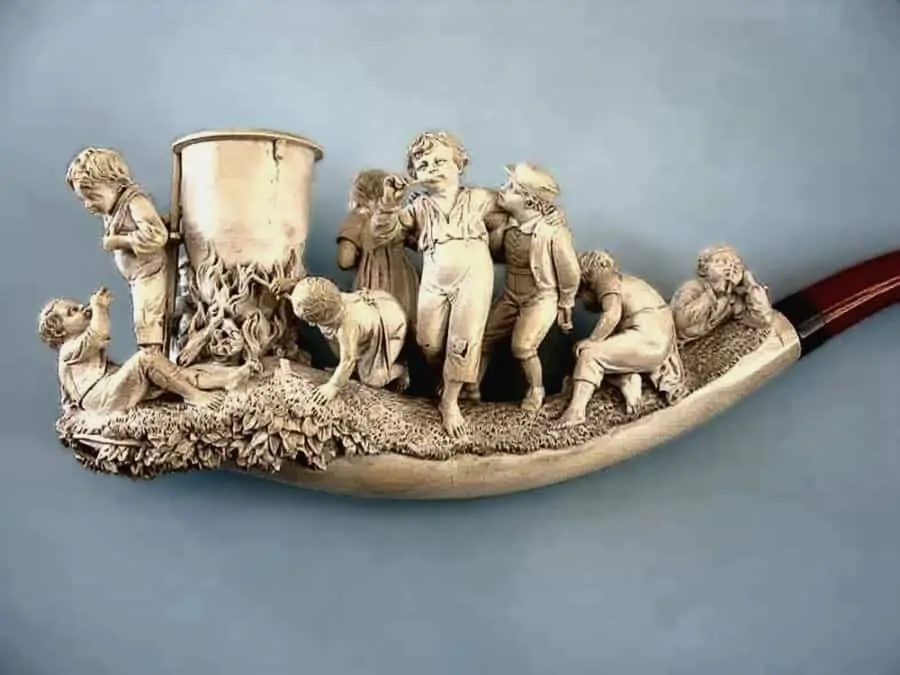
Meerschaum, from the German for “foam of the sea”, is mined from deposits of the skeletal remains of microscopic sea creatures that settled to the bottom of ancient sea beds and was compressed over millions of years. The highest quality meerschaum is found in Turkey near Istanbul. This attractive chalk white material has the consistency of soft cheese when first extracted. This facilitates the ornate and often beautiful carvings one associates with these pipes. As the material is warmed by the sun, or in a warming room, it hardens and can provide a very pleasant, cool and dry smoke. Because of it’s capacity for accepting ornate carving, meerschaum pipes became quite popular with the upper classes. It did, however, share the unfortunate trait of the fragility that plagued the clay pipe, still smoked by most commoners of the time. As a result, pipe smoking was in decline by the turn of the 19th century, being replaced by the cigar and the cigarette. There was a growing need for a robust, serviceable and economical material for pipe making.
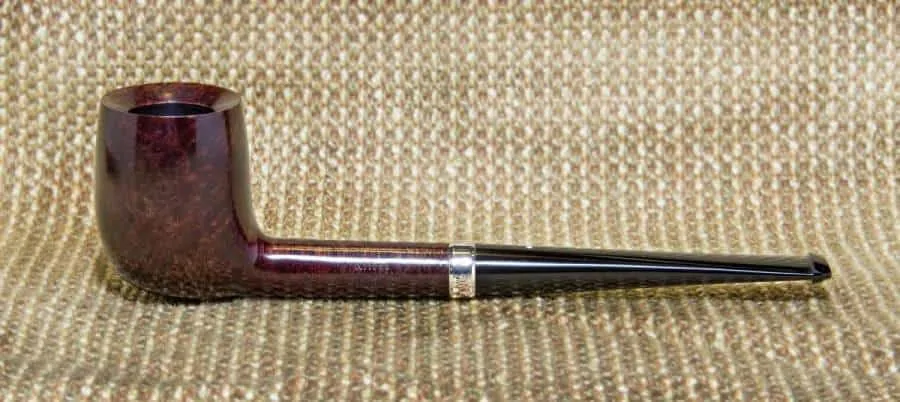
Nearly every pipe one encounters today is fashioned from briar. It is a nearly perfect material for a pipe bowl. Though fine grained and quite hard and heat resistant, briar is reasonably light weight, non – toxic, and often can be quite beautiful. And best of all, it is far more durable than either clay or meerschaum.
Some may say that the advent of the briar pipe saved the pipe smoking pastime from being supplanted by cigars and cigarettes. In the 1820’s artisans from the French town of St. Claude in the Jura Mountains, renown for their wood carving skills, began to produce pipes with bowls made from the burl of the white heath tree. (erica arborea) This wood was called “bruyere” and through the years has become known as briar.
The Mechanics of a Pipe
The mechanics, or engineering, of a good pipe is all about what is not there. The tobacco chamber, draft hole, smoke channel and slot determine the smoking qualities of a pipe. Collectively, these drillings, more so than shape, size and component materials, are the factors that yield a well smoking pipe. Just as in a well tuned high performance engine, good airflow is the critical factor for a pipe to smoke well. Unrestricted airflow, of optimal volume from bowl to button, insures the best conditions for modulation of the burn. This, in turn, allows an easy pace or regulation of puffing without undue concentration and effort required of the smoker. Optimal airflow is achieved when the smoke channel maintains a consistent “ Goldilocks ” diameter – not too small and not too large.
This means that as the height of the smoke channel must decrease to accommodate the mouthpiece tapering down to the button, the smoke channel should increase in width, gradually transitioning from a round cross section to the flattened oval opening of the slot. Think of a long, thin cone of paper that you flatten gradually from the point to the base. The ideal is to have the area of the opening along the entire length of the smoke channel consistent.
Factory brands and most high volume pipe makers generally cannot take the time to focus on this fine, but important factor. The better artisan pipe makers consider this attention to airflow requisite. That is not to say you cannot find a factory or high volume maker’s pipe that smokes well, only that a highly skilled artisan’s work is more likely to yield a good smoke.
“Is that wood?“
This is often the first question I am asked when I show my work to a non – pipe smoker. Though it may strike some as an odd one, this question usually comes from someone unfamiliar with high grade artisan pipes. Many under the age of thirty, have never encountered a proper smoking pipe “ in the wild ”. They are truly an endangered species. As the pipe stummel, or body of the pipe can be made from numerous materials, I will just briefly discuss those that have been used most often.
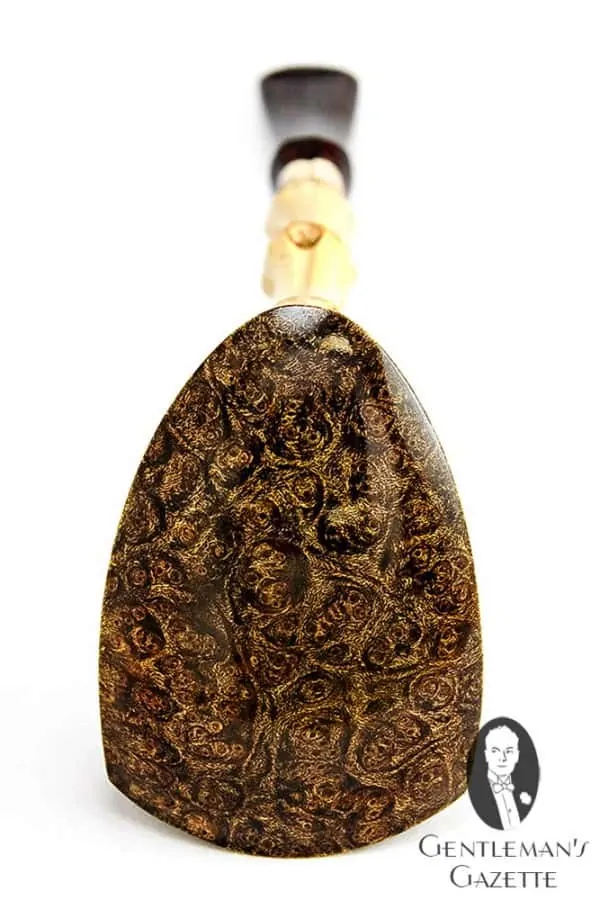
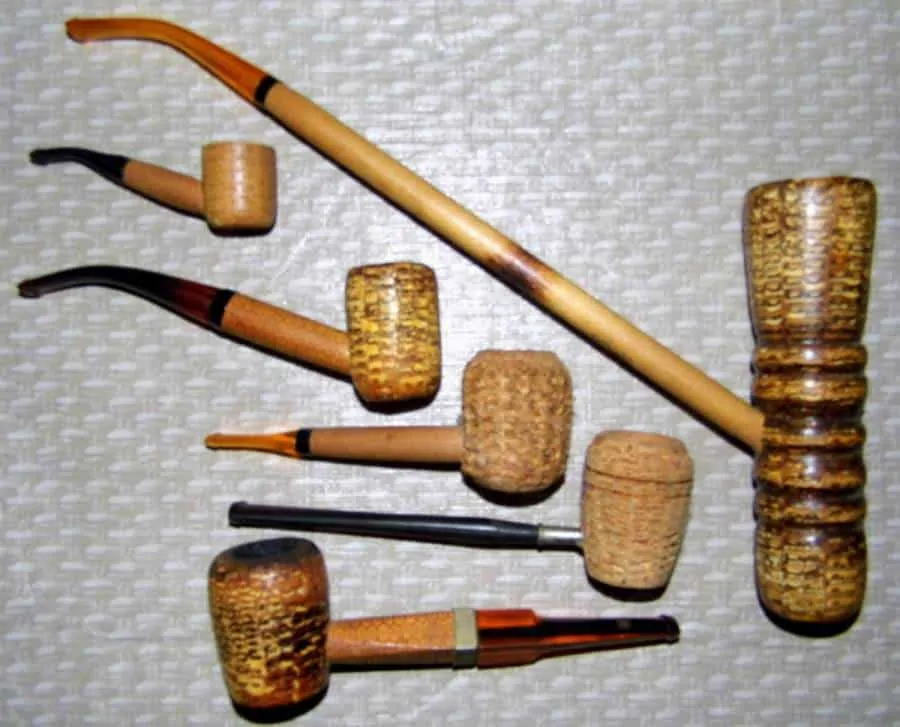
As mentioned above, by far the majority of pipes are made from briar. The second most commonly used material is meerschaum. Finding one with excellent airflow and a thin comfortable stem can require some effort as until very recently most meerschaums were produced as souvenirs for the tourist trade around Asia Minor.
Corn cob pipes are quite popular and have a long history in the U.S. Also simply called “cobs”, they are actual dried corn cobs crafted into pipe bowls and inserted with a wood shank affixed with usually a plastic or acrylic stem. Most cobs are machine made. Often used by tobacco blenders to judge new blends, they do not affect tobacco taste and are inexpensive enough to be tossed when they begin to burn out.
There are many alternatives to briar and meerschaum such as fruitwoods, bog oak, clay, ceramic and metal. Currently bog oak and strawberry wood are popular among some artisan pipe makers. Both have interesting grain patterns that can be brought out further with sandblasting. Unlike briar, most fruitwoods, bog oak and strawberry wood will not accept color stain well, nor do they achieve that beautiful patina of a well smoked briar.
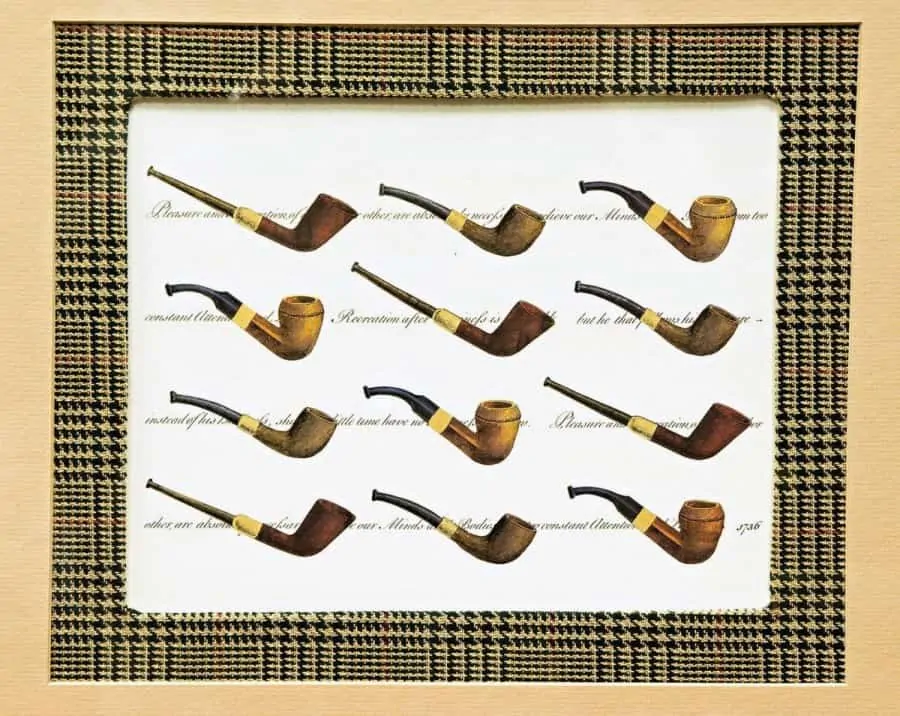
Pipe Shapes
There are more shapes and variations on shapes that one could possibly list and talented artisans create more every day. On the accompanying shape charts you can see many of the most common and classic designs.
Generally, pipes fall into two broad categories that are defined by the course of the smoke channel. These are simply straight and curved. From there, one can jump off into an ever expanding realm of marvelous and creative shapes. As to the smoking characteristics of straight versus curved pipes, there is an ongoing debate. My experience and the modest trend of opinion seems to indicate that straight pipes tend to offer a slightly better smoke. I should point out that this may be due to the fact that straight pipes are less likely to collect moisture in the base of the shank at the draft hole.
Over the centuries many styles of pipe shape have appeared and faded. in today’s pipe world they are generally thought of in terms of classic English shapes and Danish, or sometimes freehand shapes.
Classic English shapes encompass the silhouettes that we are most familiar with and mostly originated in France and England. The ubiquitous billiard shape and it’s straight and bent shank variations, the long stemmed Churchwarden recently re – popularized by the Lord of the Rings films and the venerable cutty shapes descended from the clay tavern pipes of the 1600’s are all in this group.
The classic English shapes held sway for several hundred years until about the early 1950’s when in Denmark pipe makers began to experiment with alternative shapes in an effort to inject more individual artistic expression into creation of a new and less regimented style of shapes. Many of these early creations, shaped by hand tended to incorporate the natural shape of the briar burl and direction of the grain.
This was a big move forward toward the mostly universally accepted approach to fine pipe making; working with the natural attributes of the wood to allow the pipe to reveal itself much as sculptors speak of revealing the figure in a block of marble.
Most pipe historians point to Sixten Ivarsson as the pioneer of the Danish movement and style and his shapes form the core of what many refer to as “classic” Danish shapes. Ironically, Sixten was born Swedish and moved to Copenhagen where he started this Danish revolution.
Today the classic English shapes still dominate the world’s production of pipes, though artisan pipe makers on every continent incorporate Sixten’s influences and continue to create more and more interesting and beautiful shapes with seemingly endless variations in color, surface treatments and unique combinations of materials.
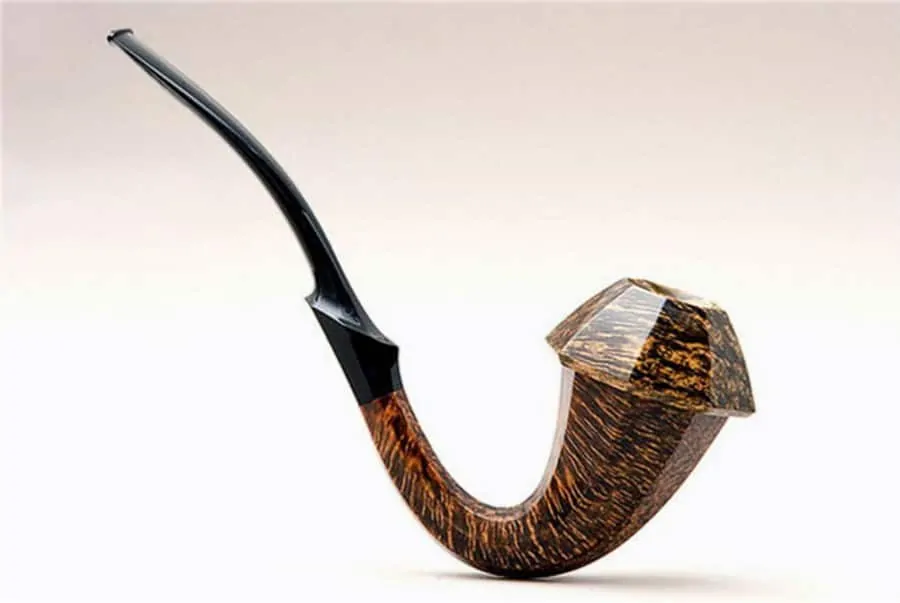
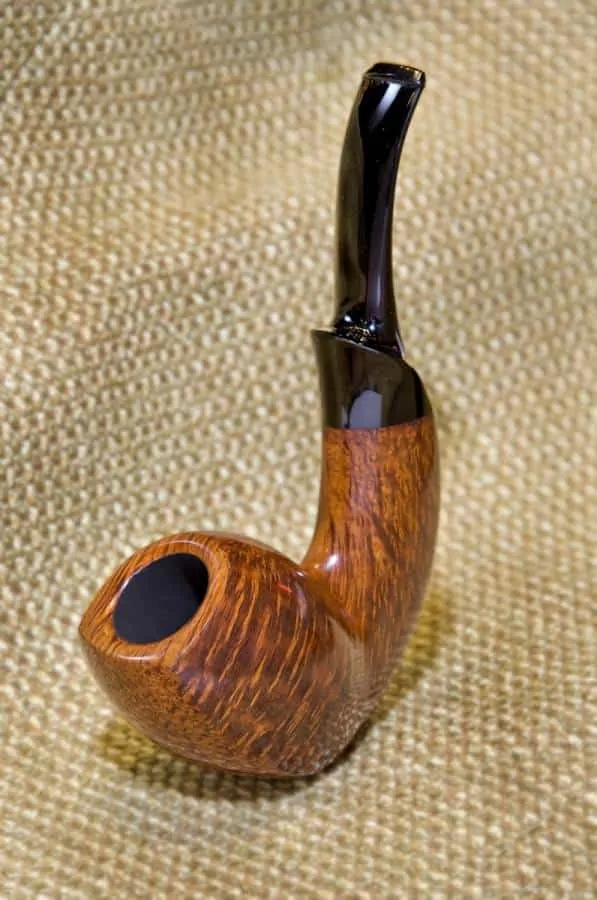
How to Smoke a Pipe
Pipe smoking, as contrasted with cigar and cigarette smoking, is considered a more relaxed and contemplative pursuit. Cigar smokers may dispute this, but I’ve never witnessed a group of pipe smokers standing in a knot in animated discussion, as is common at cigar events. Perhaps this is because of the required accoutrement of the pipe smoker. Having need of tobacco pouch, lighter or matches, pipe cleaners, extra pipes, ashtray and a tamper, the pipe smoker is better accommodated in comfortable seating with adequate table space for his requisites. The need for preparation of these items, as well as the attendant rituals of the pipe and a comfortable spot for smoking all tend to promote a relaxed and unhurried state of mind.
For more videos, take a look here.
Pacing is very important in pipe smoking and essential to appreciating all the flavor and qualities afforded by the blender’s art. A slow and deliberate pace of puffing should be cultivated into habit so that one may soon be free of the conscious effort to regulate the burning tobacco in the bowl. This is to say that patience and perseverance are required to become a successful pipe smoker; one that can discover the joys of the hundreds of different blends currently available. Patience and perseverance are also necessary to pass through the nearly universal challenge of the beginner’s “ tongue bite” period. This brief span of the first few bowls of tobacco often produces some minor irritation to the tongue and is responsible for many novices giving up on the pipe before progressing on to have the fully enthralling experience of a great bowl of superb tobacco. Just as with fine liquors and wines, there is a brief period of adjustment required in order to totally appreciate the consumption of fine tobaccos. It is therefore very important that mild, unflavored or lightly flavored tobacco blends that are not too moist be the the choice blend for introduction to the pipe. A properly engineered pipe is also of great benefit. These two factors alone recommend that a beginning pipe smoker seek advice from an experienced piper when setting out to acquire a first pipe and blend.
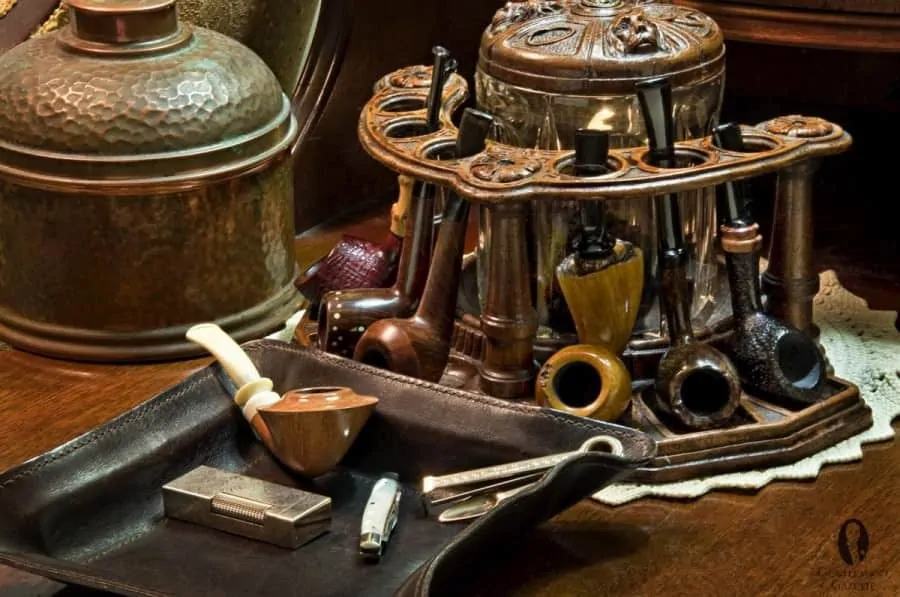
It is unfortunate these days that such knowledgeable counsel is difficult to find in most smoke shops, as their primary focus is so often on cigars. One should not ask for advice when buying a new bird gun in the fishing dept. Again patience and deliberation are called for at the very beginning of a pipe smoker’s odyssey. What is fortunate is that experienced pipe smokers are pretty much universally pleased to help, advise and mentor those who wish to take up the pipe and join our venerable ranks.
How to Buy a Pipe
There are two main categories of pipes offered for sale: new and estate.
New pipes are just that: un-smoked and never sold before. On the other hand, estate pipes are pre-owned and offer a great opportunity to get a very good pipe for half or less of the normal price at retail. These estate pipes can be smoked or un-smoked. Pre-smoked pipes offer the greatest chance at an excellent bargain and, when properly cleaned and sterilized with any potable alcohol, can be truly marvelous acquisitions. I have been able to smoke pipes made by some of the finest pipe makers in the world by purchasing their creations on the estate market. Imagine finding a pre – war top of the line John B. Stetson, or a real Ferrari Dino for pennies on the dollar. Estate pipes represent such an opportunity. If you have no issues with using restaurant silver and glassware, you should have no problem smoking an estate pipe once it has been properly cleaned and sterilized with alcohol.
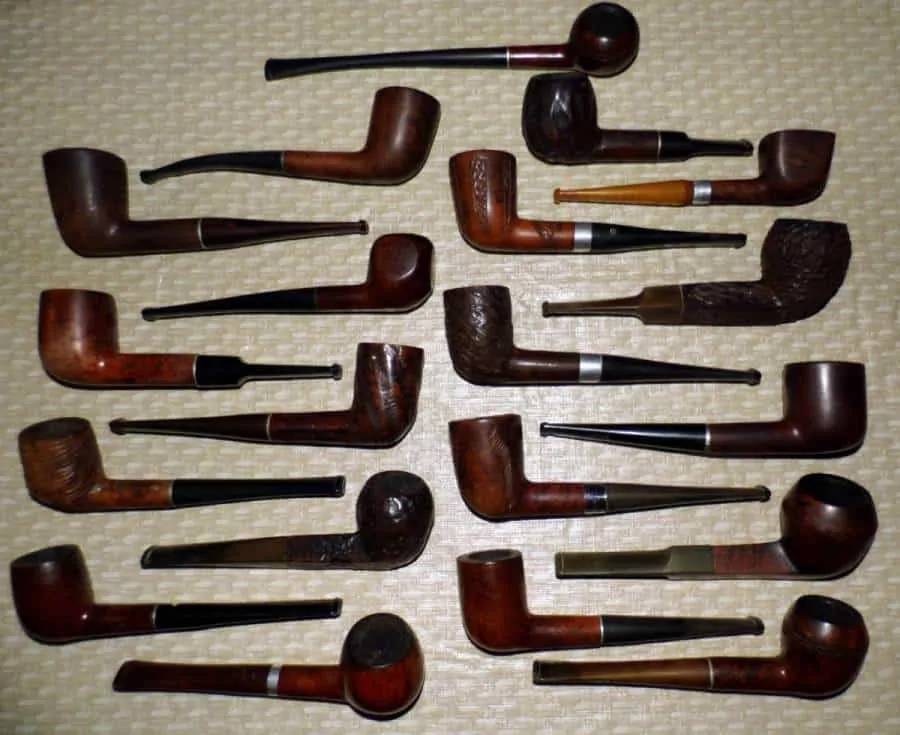
How to Sanitize a Pipe
- Buy Pipe cleaner – you should have soft ones and hard ones – and sanitizing grain alcohol, NOT isopropyl alcohol. Optionally, use an ultrasonic cleaner with warm water to remove resin and tar from the estate pipe, speeding up the entire cleaning process tremendously. However, on some pipes it might weaken the epoxy joints of horn, ivory or metal band editions.
- Separate the components of the pipe by sliding or unscrewing the stem from the bowl.
- Dunk a hard pipe cleaner into the alcohol and clean the pipe stem by running it back and forth. If you think it is clean, insert a dry pipe cleaner. If it comes out clean, you are done, otherwise repeat this step. Never reuse pipe cleaners but they are so inexpensive that you won’t mind throwing them away.
- Remove resin and tar build-up on the inside of the bowl with a scraping tool.
- Fold an alcohol drained pipe cleaner in half and Clean the bowl and the tenon (the air hole inside the bowl of the pipe) by gently rubbing the sides of the bowl and sticking the pipe cleaner into the tenon. All residue should be wiped off with a dry pipe cleaner.
- Rub and wipe the outside of the bowl with alcohol on a paper towel or cloth and let it dry.
Sources for pipes
There are many ways to find yourself a pipe. Pipe shops, online retailers, artisan web sites, Ebay, pipe shows, antique stores, estate sales and flea markets all offer the opportunity to purchase a fine pipe.
Most cigar shops also sell pipes but you will hardly find any standalone pipe shops anymore. Due to the anti – smoking movement and the Draconian increase in federal excise tax on tobacco in the U.S. enacted in 2009, many excellent small shops have closed their doors. Most of those that remain have pared down their pipe offerings to lower and mid market factory brands. There is a handful of pipe shops in the U.S. that still stock a good selection of pipes ranging from lower end factory pipes to the ultra high end pipes created by the world’s finest pipe makers. Such retailers are also knowledgeable about their pipes and the tobaccos they stock. Among these are:
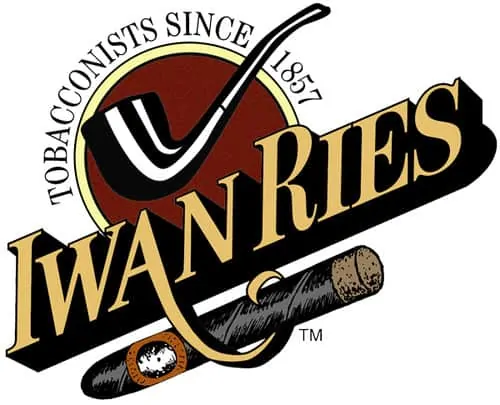
U.S. pipe shops
Uptown’s Smoke Shop, Nashville, TN
Low Country Pipe and Cigar, Myrtle Beach, SC
International pipe shops:
James J. Fox, St. James, London
Peter Heinrichs, Cologne, Germany
Pipe and Tobacco shop Keigai Tokorozawa, Saitama City, Japan
The internet is a great boon to the pipe smoking enthusiast hoping to purchase an excellent pipe or locate some rare tobacco. One can directly contact many of today’s very best artisan pipe makers, online retailers, most brick and mortar shops and there are literally tens of thousands of items under “ pipes” on Ebay. However, a huge percentage of them are, if not junk, then at least not to be recommended. Purchasing pipes or anything on Ebay can be fun and the possibilities of finding a bargain on a jewel are frequent, but such purchases are best postponed until one has gained the experience to be a savvy buyer.
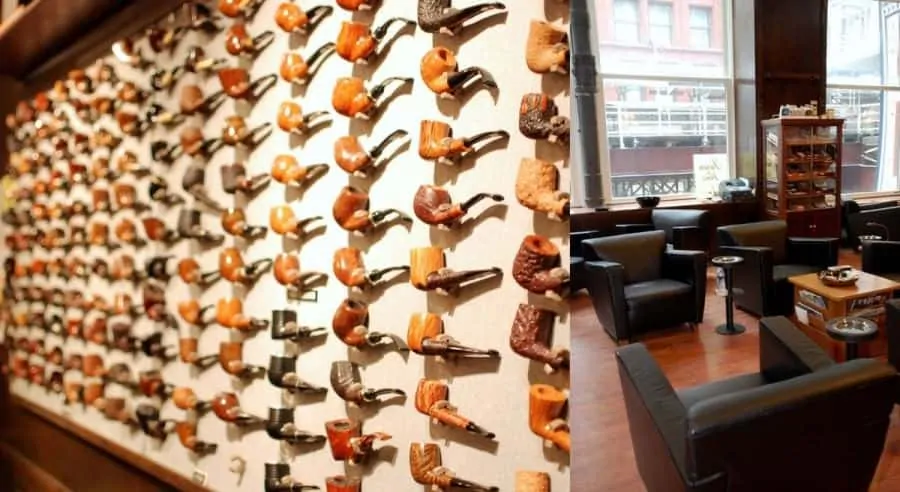
Many fine online retailers offer a huge variety of pipes and many of the finest pipes made today are sold online by very reputable, knowledgeable and service oriented vendors, such as:
Nick Miller’s Quality Briar
A good reputation is vital to these vendors so they pay careful attention to provide good service and often go above and beyond the usual return privileges one can expect from any good retailer. Most online retailers also offer estate pipes.
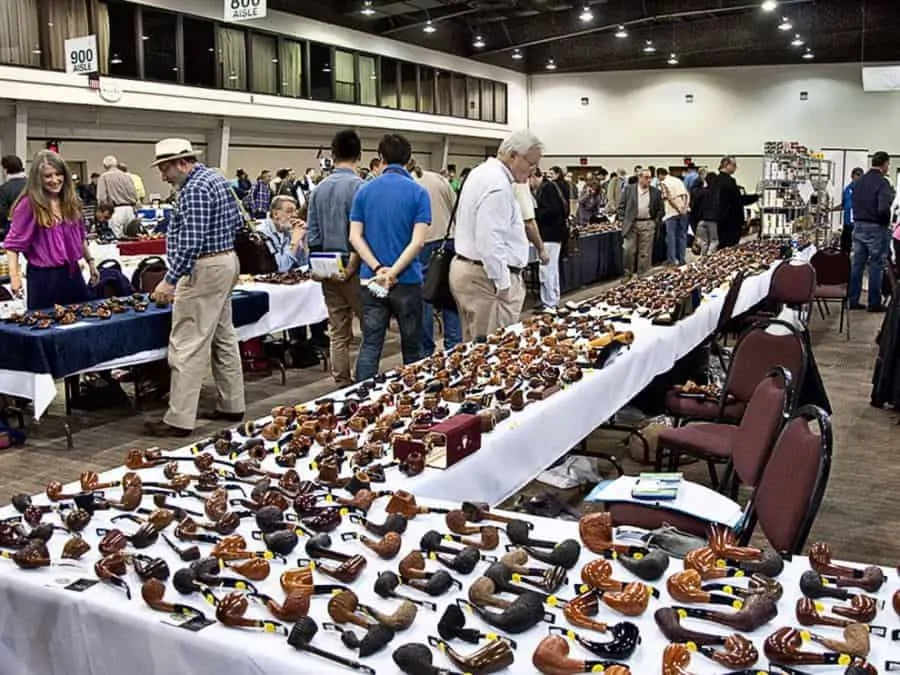
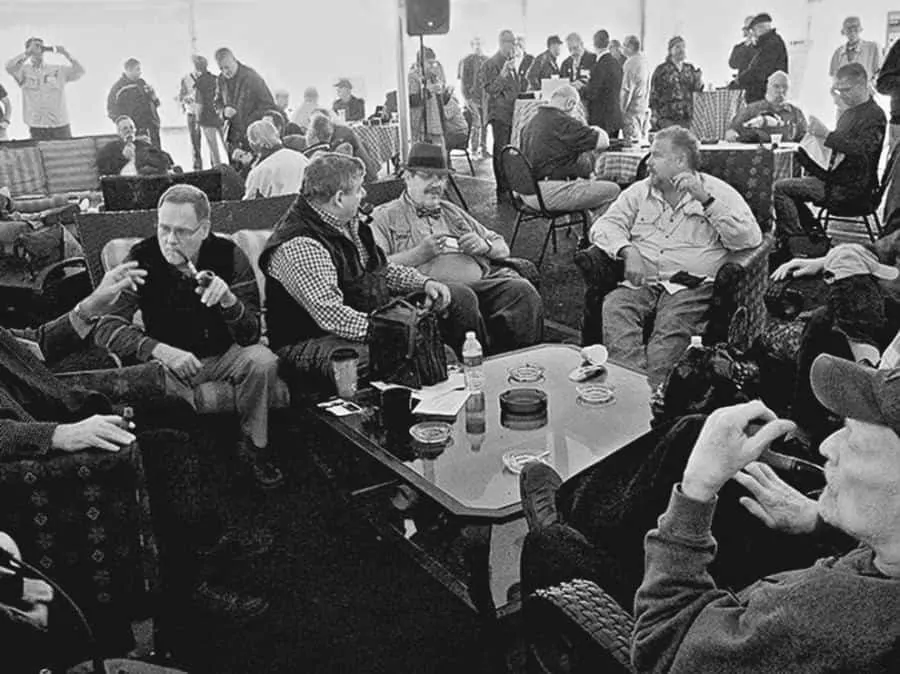
Pipe shows
My favorite way to secure a new addition to the “herd”, as pipers often refer to their collections, is to do so at a pipe show. Pipe shows are held all over the globe these days and are very much like any sale and show event such as antique shows, gun shows, jewelry shows and craft fairs. At these ( usually ) weekend events like minded collectors, pipe and tobacciana vendors, factory reps and individual artisans gather to sell, trade, swap and revel in all things “pipe”. One of the best aspects of the pipe smoking community is that it is made up of some very fine, friendly and discerning folks and they like nothing better than to get together at a pipe show.
Along with very pleasant activities of commerce, one will find a great deal of socializing, catching up with old friends and people making new friends from all points of the compass. Most shows are annual affairs and the largest and perhaps oldest and best known is the Chicagoland Pipe and Tobacco Expo held each year in St. Charles, Il which is just outside of Chicago. Pipe aficionados from all over the world converge on the Pheasant Run Golf Resort and for three or four days the hotel is virtually taken over by the hundreds of happy attendees. I can recall several years ago at the “ Chicago show” as it is known, sitting in the packed bar smoking my pipe (which was permitted at the time ) , looking around and seeing men and women of all ages and socio-economic, ethnic and political backgrounds. I heard conversations in Japanese, French, Italian, Austrian, Danish, Spanish, Portuguese and English; all well fuelled by alcohol, and I could not detect one unpleasant exchange or untoward look. It is an experience I shall not forget. And, it is one that has been repeated often in variations at many, many pipe shows since. Though the smoking and drinking now take place in well appointed tents erected a few steps away from the show hall, the atmosphere of comradeship and fraternity ( and sorority ) still abound at pipe shows. For the true pipe smoker and aficionado, such events are not to be missed.
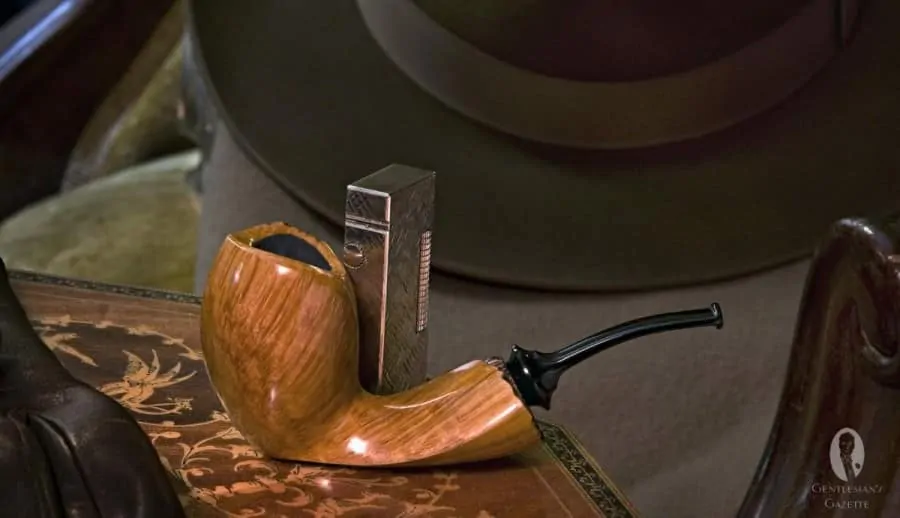
Buying from a Pipe Maker
Another very fine, though quite different, buying experience can be purchasing or commissioning a pipe directly from an artisan pipe maker. While pipes of all levels of quality and price can be found among the artisan makers, they all seem to share the same friendly and approachable attitude. One does not become a pipe maker to become wealthy. As with most artists, theirs is a labor of love and showing interest in their work is a gratifying experience for them. I found this to be equally true of fledgling craftsman and the grand masters of the art. They are passionate about their efforts and are happy when others show an interest. In this regard one should be aware that time spent away from the briar is unrecoverable and each piece is individually hand crafted by the artisan himself, so it is not only polite, but wise to be considerate of his or her time when conducting business. It is also well to keep in mind that while artisans are indeed in business, they are not factories or mass suppliers of goods. Stocks of pipes are not kept on hand and commissioned work takes time to produce. The themes of patience and perseverance arise in this aspect of the hobby as well as in the honing of one’s smoking technique. Direct interaction with artisan pipe makers can be extremely satisfying and has often led to many lasting friendships. I have a collector – now friend – that told me he only buys pipes from makers he knows and likes. This is a truism among collectors and again points up the friendly social aspects of pipe smoking and collecting.
Pipe brands and makers
Very high quality artisan makers:
Lars Ivarsson
Tom Eltang
Jess Chonowitsch
Rainer Barbi
S.Bang
H. Tokutomi
Former
K. Gotoh
Smio Satou
Roman Kovalev ( Doctor’s pipes )
Viktor Yashtylov
Palo Becker
Cornelius Manz
Quality Factory/ high output handmade pipes:
Castello
Dunhill
( older ) Stanwell
Defunct marks that are still widely available:
W.O. Larsen
James Upshall
Charatan
Barling
Saseini
Becker y Musico
Because I am a North American pipe maker, I shall not even try to list all of them in fear of leaving out a deserving friend. I may be able to dedicate a future posts just to North American pipe maker’s, so stay tuned.
Recommended Reading
If you now want to learn more about the topic of tobacco pipes, I recommend you buy the book In Search of Pipe Dreams by Rick Newcombe and to take a look at the magazine Pipes and Tobacco magazine.
Conclusion
Impossible to recreate for comparison or measurement any aspect of pipe smoking for objective observation. Tobacco blend, humidity, altitude, ambient temperature, pace of puffing, pipe shape, pipe materials and pipe condition are just a few factors that affect the smoker’s experience. Judging food, liquor, or even cigars is far less challenging. The good news is that smoking your blend, in your pipe, your way, is truly a unique and sublime experience in today’s frequently rough, often uncivil and contentious society. It is a true luxury that thankfully is available to virtually any adult. For now, that is.
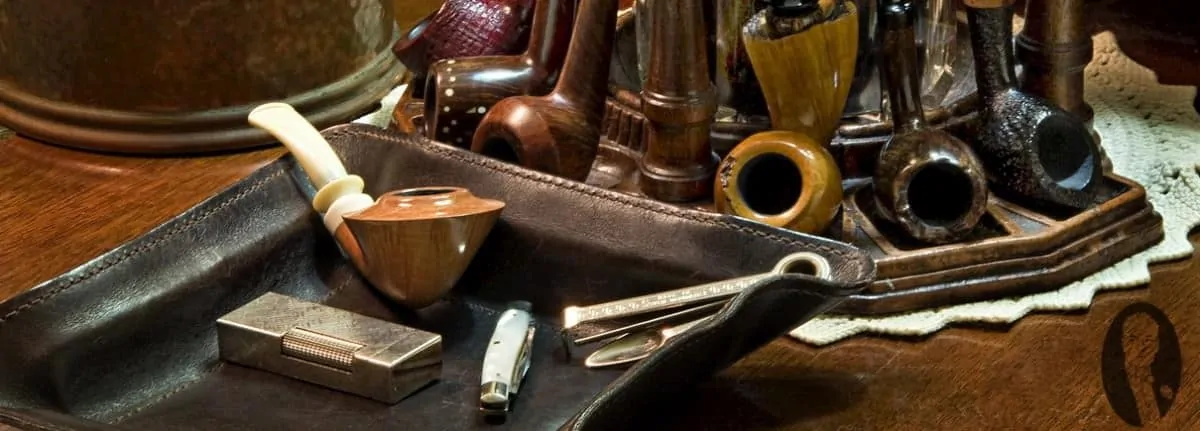
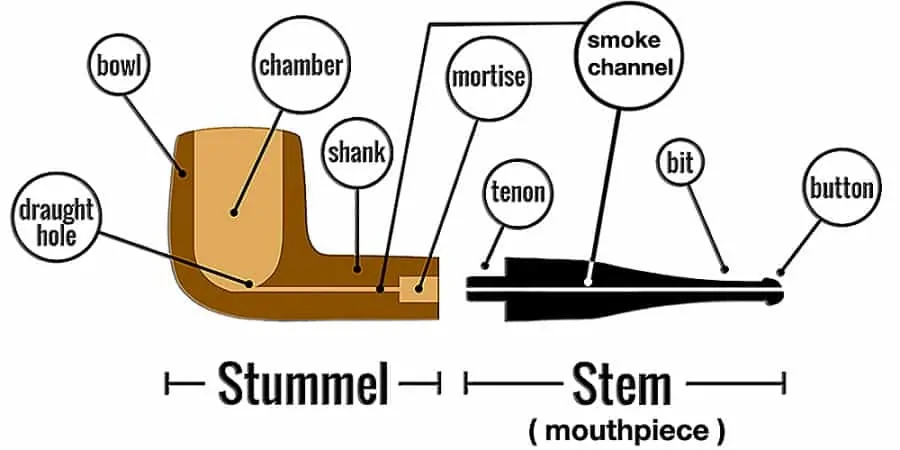
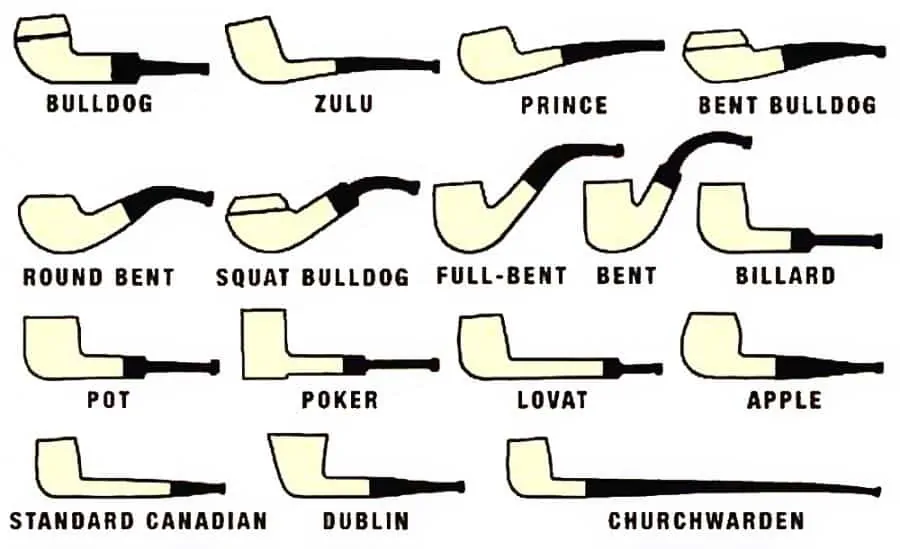
Got to love Your Site. Interesting and Informative Articles.
In particular, Tweeds, Dress Hats and Waistcoat Articles.
I am an avid Pipe Smoker for 40+ years.
I smoke only natural English Style Tobacco. In a Peterson.
Thanks for your kind words Thomas!
As a fellow pipe smoker I can’t help but agree with everything that’s been said in this article. It’s something magical to just sit back and relax with a bowl of your favorite tobacco and contemplate on life. It’s lessens your stress and helps wrap your mind around things that have been bothering you. For you really are never in a rush when you’re smoking your pipe.
A most informative article. Bravo!
Ive never smoked anything but cigars before but this sounds so classy and relaxing.i definately must try smoking a pipe. Do you need a humidor for your tobacco?
Wish I had a friend who could teach me
You don’t have to have a humidor because most of the tobacco is already dried and it makes it a little harder to light with a moister tobacco for your pipe anyway. Most people, that I’ve ran across, store tobacco in relatively normal area(such as a pantry) away from the light and in mason jars. Keeps your tobacco fresh for a long time.
Thanks for helping out Ebag! We will write a few more pieces about pipe smoking, including tobacco…
Hello Jonathan,
A humidor is not necessary at all. Tupperware type containers work fine, as do good quality
double seal plastic bags. Just keep it out of direct sun and extremes of temperature and
humidity.
Here is a good source for all sorts of pipe smoking information and the also have a
good forum section too:
http://pipesmagazine.com
Much good luck to you Sir!
Steve Morrisette
One of the most pleasant evenings I have ever had up to this time was spent at home alone with a dram of single malt; a pipe filled with Pipe Makers Blend by Pipeworks & Wilkie; and a new recording of “The Magic Flute”. I listened the night away puffing slowly on my big Castello, wondering whether anything else in life could be this perfect.
Another great article! I only wish I had more time to sit for awhile and get through a whole bowl of tobacco.
I remember in 1975 when I was 5 years old, my father smoked a pipe, kept the wicks tobacco and everything he needed in a drawer.
I always was going to sneak in , opened it to smell the scent that tobacco had given the wood of the drawer.
I will never forget that smell.
a few years ago, despite not being a smoker, I decided to start smoking a pipe and I’m reliving those scents …
very interesting article thanks as always …
Alessio
Another great article on pipe smoking, I have been selling estate pipes on ebay for 8 yrs, and my pipes go all over the world. It fascinates me that there are so many people still smoking pipes, my friends can’t understand how I sell ten refurbished estate pipes every week. In the U.K. nearly all the pipe and tobacco shops have closed down, maybe you will find some in London and the big cities, so the internet is such a great way to peruse thousands of pipes. If anyone is interested in buying an estate pipe, my username on ebay.co.uk is – milley123dog.
Thankyou for reading my message
Regards
Malcolm.
What are the opinions on Petersons of Dublin, pipes and products?
Hello Sean,
My experience with Petersen pipes and what I’ve learned from several retailer friends of mine is that they are ok. Not great, not awful. They seem to sometimes suffer from QC issues which is not uncommon with mass produced pipes. Apologies to the Petersen lovers out there – and there are quite a number.
This is just one man’s opinion and experience so, YMMV, as they say.
Thank you for your question and…
Best regards,
Steve Morrisette
Dear Sven
I so much enjoy your site. Authorative, interesting and very in-depth articles. I really enjoy this apsect so that i can understand the history of the item which places it in context for me. Superb.
The article on pipe smoking hit a cord with me as i have been looking at this subject, along with cigar smoking, for some time now. I just cannot seem to take the plunge and start since we all know it is bad for us but, i can still enjoy the history.
On that note, the first photograph in the pipe article has really caught my eye – the pipe stand. It is simply stunning and i was wondering if this was a collectable piece of the authors and, if it was for sale? Could the author provide any more information on it – for example its provenance and how best to come about such items. The author mentions a pipe show which i will need to look in to as i have never heard of one, but any further information would be most appreciated.
Rebewed thanks and an excellent site as always
Regards
Bradley
Hello Bradley,
Thank you for your very kind comments.
The pipe rack you reference is one of many I acquired by scouring EBay.
It is made of a material called Synjeco, which appears to be a sort of hybrid of plaster and papier mâché.
It was popular during the mid last century –
1940-1960’s. I believe I shall hang on to it. 8^)
Regarding pipe smoking and your health, the U. S. Surgeon General report of 1964, the one that began all the anti-smoking policy DOES list in it’s analysis of results that PIPE smokers have been shown to live as long as, or LONGER than subjects that had never smoked at all.
This is conveniently
ignored by most anti-smoking advocates.
I know many men that have been pipe smokers most of their lives and several are in their upper 80’s.
As in all,
things,operation is the key.
Much good luck to you,
Steve Morrisette
The should read: “moderation is the key”
iPhone spell check strikes again.
Thank you so much for the fantastic article, in addition to men’s dress, I have slowly been becoming involved in pipe culture-though alike the aforementioned commentary it is often hidden in cache. That said this article not only continued my appreciation of pipe history but also helped to answer many of my “novice” inquiries. Thank you again.
Andrew
Dear Mr Morrisette,
thanks you very much for this your most insightful article. Furthermore, the pipes of your production shown in this article are real pieces of art and have given me an understanding of your most admirable profession.
Greetings from across the Atlantic.
This is a wonderfully written article, unlike the article in GQ. It was VERY degrading. I have been smoking a pipe for nearly 31 years and can say the only smoke I DIDN’T enjoy was a bowl full of straight Perique. I highly recommend pipe smoking and I try to make myself visible with a pipe as much as I can, thankfully I look young enough to turn younger smokers to the pipe.
Thanks for your comment Menachem! What GQ article are you referring to? I think most people would agree that our coverage far exceeds their’s ;).
Great article. I have a pipe every now and then, mostly in warmer weather when I can enjoy it outside. In the interest of fair reporting, however, I have to weigh in on the 1964 Surgeon General report. As a medical researcher, I get tired of this thing being brought up over and over again. Yes, the report did conclude “The death rates for pipe smokers are little if at all higher than for non-smokers, even for men who smoke 10 or more pipefuls a day and for men who have smoked pipes more than 30 years.” But what’s “conveniently ignored” is this from the same report: “Ex-cigar and ex-pipe smokers, on the other hand, showed higher death rates than both non-smokers and current pipe or cigar smokers” and “The explanation is not clear but may be that a substantial number of such smokers stopped because of illness”. In other words, the results for “current” pipe smokers may be biased since those who got sick may have stopped smoking and therefore are not included in the denominator (i.e. being counted). This is a huge potential flaw in the conclusion. Also never mentioned is the finding from the same report that “The causal relationship of the smoking of pipes to the development of lip cancer appears to be established. Although there are suggestions of relationships between cancer of other specific sites of the oral cavity and the several forms of tobacco use, their causal implications cannot at present be stated.” This report is now 50 years old. There have been several studies since then that have shown increased risk (though much less than cigarette smoking) associated with pipe smoking, ESPECIALLY when accompanied by alcohol drinking. Research also shows that many pipe smokers inhale (per self-report), especially among those who have switched from cigarettes to pipes. I think it’s important for people to know that pipe smoking is (a) not as risk-free as the often-quoted 1964 SG report suggests, (b) increases the risk of oral cancer substantially when accompanied with an “adult beverage”, and (c) contains carcinogens just like any other tobacco product that increases ones risk with increased exposure. Those wanting to enjoy a pipe while minimizing their risk should do so in moderation (probably no more than 1 per day, based on more modern research), should restrict their alcohol intake to no more than 1 drink per day (based again on modern research) and not while smoking, should not inhale directly, and should minimize inhalation of sidestream and room-smoke. Sorry to be a downer, but the decision to pick up the pipe should be based on more than a single (possibly flawed) conclusion from one research report from 50 years ago. I’m sure this post will be attacked and I’ll be accused of being an “anti.” The fact is, the pipe smoking hobby is not going to win over non-smokers or bring pipe smoking into social acceptance until it can show (through research) that it’s members are not at significant increased risk. This means educating pipe smokers to not be cavalier about smoke, discussing health issues, current research, and ways to reduce risk, none of which I see (e.g. Pipes Magazine, P&T magazine, NASPC, etc) or hear (OomPaul and Pipes Radio podcasts) in the pipe smoking hobby.
Paul, thank you for your detailed comment. I agree everybody should decide with all the facts present, however you also have to outline similar cancer or health risks from things like sodium laureth sulfate or charred meats…
Another wonderful article. I want to add that in my city they can find good shops of pipes and tobacco. For 20 years that I am not smoking, but I am thinking of returning to smoke in pipe, this serious harmful to my health?. Thank you again. A greeting from Barcelona
Really nice to read such a great article on the pleasure of smoking tobacco (without any histerical yelling of the anti-tobacco lobby).
I think any full-grown man is capable of knowing what’s right and what’s wrong for him.
Plus we don’t have to forget the vast influence of this holy leave on our civilization, i.e. on economics, culture (early european coffee-houses where people gathered, drank coffee and smoked tobacco had the first democratic movements and discussions in the western world) and behavior (the mayans thougt,at first the gods made tobacco and then followed mankind)
So keep your vision clear, don’t let the herb controll you, allways keep controll and simply enjoy a bowl of damn good tobacco.
Greetings from Germany,
Bob
P.S.: I really recommend to watch the BBC-Series “Addicted to pleasure”, there is one episode on the history of tobacco. Very worth watching!
Steve, you have put a great amount of research and knowledge into this article. Congratulations.
From my perspective, I am a full time pipe restorer. I feel it is an important role to try and bring old pipes back to life to be enjoyed again by a new smoker. If trated well, a good briar pipe will last more than a lifetimg – and possible 2 lifetimes or more! In many instances, these pipes represent a piece of history of our hobby. Many of the old classic pipes are no longer produced, and if they are – not to the same quality standards as in the past.
I am jealous of the number and scale of the pipe shows available in the USA. It is ironic that during the heyday of pipe making, the hub of world production was based in London. Yet today there is only one pipe show per year in the UK which is poorly attended. They are trying to drag themselves back from several years of cancellations due to our draconian anti-smoking laws.
This year’s show is being held on 13th July 2014 at Newark-On-Trent in England and it would be great for as many pipe smokers as possible in the UK to attend and support this last major bastian of our hobby this side of the Atlantic. Pipes from many of the top artisan pipe makers around the world will be on display. More details of the UK Pipe Show and Pipe Smoking Championship can be found at http://www.pipeshow.co.uk.
Thank You
Alan Chestnutt